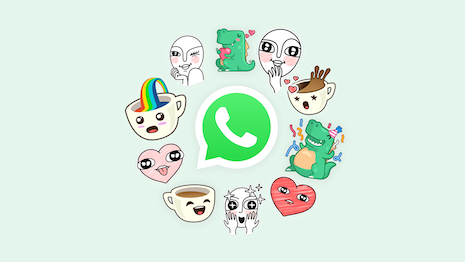 New face of messaging: WhatsApp stickers. Image credit: WhatsApp
New face of messaging: WhatsApp stickers. Image credit: WhatsApp
By Beerud Sheth
As 2018 draws to a close, it is a good time to take stock of the year in the world of messaging and conversational experiences.
Unlike prior years, this one is characterized by less hype and more progress.
Developers have been quietly working away, far from the madding crowd, as messaging volumes grow massively and conversational experiences continue to pervade every aspect of human existence.
Getting the message across
Over the last few years, mobile messaging usage has exploded. It now dominates smartphone usage.
While consumer communication grew rapidly a few years ago, the more recent and interesting phenomenon is the rise of “messaging as a platform” – a platform for developers and marketers to engage their customers and build advanced conversational experiences.
Messaging and conversational experiences are gradually transforming every aspect of the human-computer interface.
Facebook Messenger, which launched its bot API with great fanfare in 2016, is now coming of age. Facebook this year disclosed that more than 300,000 chatbots were developed on its platform.
Messenger has by far the most technically advanced APIs, tools and platforms for chatbot developers. It also offers open access to all developers and does not charge a messaging fee. Therefore, it is often the first channel that developers experiment with, even if the bot is ultimately deployed on another channel.
 Cheat chat: Many platforms of messaging. Image credit: Gupshup
Cheat chat: Many platforms of messaging. Image credit: Gupshup
In another major new development this year, Facebook-owned WhatsApp launched its "WhatsApp for Business" platform – an API for enterprises to send automated messages to consumers.
In most parts of the world, except United States and East Asia, WhatsApp is the dominant messaging channel. The frequency and intensity of WhatsApp usage dwarfs any other communication channel in those countries.
While that has only been the case for consumer-messaging so far, the new APIs will now attract enterprise-messaging volumes.
Marketer usage is expected to grow as WhatsApp adds more features, expands developer access and fine-tunes its pricing and policies.
RCS, the successor to SMS, continued its slow progress this year.
Wireless carriers in Japan went live with a joint RCS service, making it the first country with full RCS coverage. It will be interesting to see which channel enterprises and consumers prefer, as RCS and Line battle for messaging volumes in Japan.
In all likelihood, they will both grow, as there is immense potential for additional use cases to migrate from applications to messaging.
In the U.S. this year, AT&T went live with RCS, while Verizon enabled it on a few devices.
Worldwide, as other operators continue to look at RCS, the deployment timelines are either less clear or very long.
Handset manufacturers are slowly starting to enable RCS on their devices. However, the "elephant in the room" is what will Apple do – its position remains unclear.
Finding its voice
Meanwhile, Amazon’s Alexa, the leader in voice-based conversational services, continues its march through the kitchens and living rooms of consumers.
In 2018, Amazon introduced many different form factors combining audio speakers and screen-based interfaces. Additionally, it also offers cloud APIs for others to embed Alexa into their devices.
At the same time, Google Assistant is marching onto Android smartphones worldwide, with support announced in 2018 for 30 languages in 80 countries.
The rise of Alexa and Assistant shows that, depending on context, users will seamlessly use both oral and textual conversations to get things done.
For example, in private spaces with busy hands – e.g. when driving or cooking – audio is the preferred conversational medium. However, in public spaces – e.g. meeting room or noisy street – screen-based textual or visual interaction is usually the preferred mode.
Even as other channels mount a bid to be viable alternatives, SMS continues to remain the preferred channel for enterprise messaging, given its ubiquity.
Globally, marketers send 2 trillion text messages to consumers worldwide. These are mostly transactional messages notifying customers about information related to their transaction.
This year messaging global volume grew by about 10 percent, according to market research firm Mobilesquared, which is not bad, given its massive scale.
While SMS does have limitations such as plaintext, restricted-length format, it more than makes up for it with its reach and ubiquity.
Other services thrive as well, with varying degrees of success.
Telegram continues its standoff with Russian regulators who want access to its encryption keys.
Viber launched new features enabling massively large communities along with monetization tools for moderators.
While other channels continue to develop, the gold standard worldwide for rich messaging functionality remains WeChat, along with similar apps Line and Kakao.
These messaging apps enable users not just to communicate but also do a wide variety of transactions, including shopping, banking, insurance, payments, travel, taxis, food delivery, jobs, music and news. They have now become super-apps that subsume many other apps within them.
Indeed, these are powerful illustrations of the vision of “messaging as a platform.”
MESSAGING CHANNELS and conversational experiences continue their rapid growth even as the hype cycle has moved on.
As they say, it is easy to overestimate the short-term and underestimate the long-term. That is certainly the case with messaging and conversational experiences.
As messaging functionality and AI/NLP capabilities reach an inflection point, it is advisable not to underestimate 2019.
 Beerud Sheth is founder/CEO of Gupshup
Beerud Sheth is founder/CEO of Gupshup
Beerud Sheth is founder/CEO of Gupshup, San Francisco. Reach him at [email protected].
